Occipital artery
| Occipital artery | |
|---|---|

The arteries of the face and scalp. (Occipital visible at center left.)
|
|

Superficial dissection of the right side of the neck, showing the carotid and subclavian arteries.
|
|
| Details | |
| Source | external carotid artery |
| Vein | occipital vein |
| Supplies | occiput, scalp |
| Identifiers | |
| Latin | arteria occipitalis |
| Dorlands /Elsevier |
a_61/12155290 |
| TA | A12.2.05.030 |
| FMA | 49586 |
|
Anatomical terminology []
|
|
The occipital artery arises from the external carotid artery opposite the facial artery. Its path is below the posterior belly of digastric to the occipital region. This artery supplies blood to the back of the scalp and sterno-mastoid muscles, and deep muscles in the back and neck.
At its origin, it is covered by the posterior belly of the digastricus and the stylohyoideus, and the hypoglossal nerve winds around it from behind forward; higher up, it crosses the internal carotid artery, the internal jugular vein, and the vagus and accessory nerves.
It next ascends to the interval between the transverse process of the atlas and the mastoid process of the temporal bone, and passes horizontally backward, grooving the surface of the latter bone, being covered by the sternocleidomastoideus, splenius capitis, longissimus capitis, and digastricus, and resting upon the rectus capitis lateralis, the obliquus superior, and semispinalis capitis.
It then changes its course and runs vertically upward, pierces the fascia connecting the cranial attachment of the trapezius with the sternocleidomastoideus, and ascends in a tortuous course in the superficial fascia of the scalp, where it divides into numerous branches, which reach as high as the vertex of the skull and anastomose with the posterior auricular and superficial temporal arteries.
...
Wikipedia
